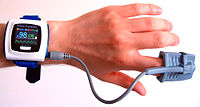
Photo from wikipedia
Background Remote home monitoring of people testing positive for COVID-19 using pulse oximetry was implemented across England during the Winter of 2020/21 to identify falling blood oxygen saturation levels at… Click to show full abstract
Background Remote home monitoring of people testing positive for COVID-19 using pulse oximetry was implemented across England during the Winter of 2020/21 to identify falling blood oxygen saturation levels at an early stage. This was hypothesised to enable earlier hospital admission, reduce the need for intensive care and improve survival. This study is an evaluation of the clinical effectiveness of the pre-hospital monitoring programme, COVID oximetry @home (CO@h). Methods The setting was all Clinical Commissioning Group (CCG) areas in England where there were complete data on the number of people enrolled onto the programme between 2nd November 2020 and 21st February 2021. We analysed relationships at a geographical area level between the extent to which people aged 65 or over were enrolled onto the programme and outcomes over the period between November 2020 to February 2021. Findings For every 10% increase in coverage of the programme, mortality was reduced by 2% (95% confidence interval:4% reduction to 1% increase), admissions increased by 3% (-1% to 7%), in-hospital mortality fell by 3% (-8% to 3%) and lengths of stay increased by 1·8% (-1·2% to 4·9%). None of these results are statistically significant, although the confidence interval indicates that any adverse effect on mortality would be small, but a mortality reduction of up to 4% may have resulted from the programme. Interpretation There are several possible explanations for our findings. One is that CO@h did not have the hypothesised impact. Another is that the low rates of enrolment and incomplete data in many areas reduced the chances of detecting any impact that may have existed. Also, CO@h has been implemented in many different ways across the country and these may have had varying levels of effect. Funding This is independent research funded by the National Institute for Health Research, Health Services & Delivery Research programme (RSET Project no. 16/138/17; BRACE Project no. 16/138/31) and NHSEI. NJF is an NIHR Senior Investigator.
Journal Title: EClinicalMedicine
Year Published: 2022
Link to full text (if available)
Share on Social Media: Sign Up to like & get
recommendations!